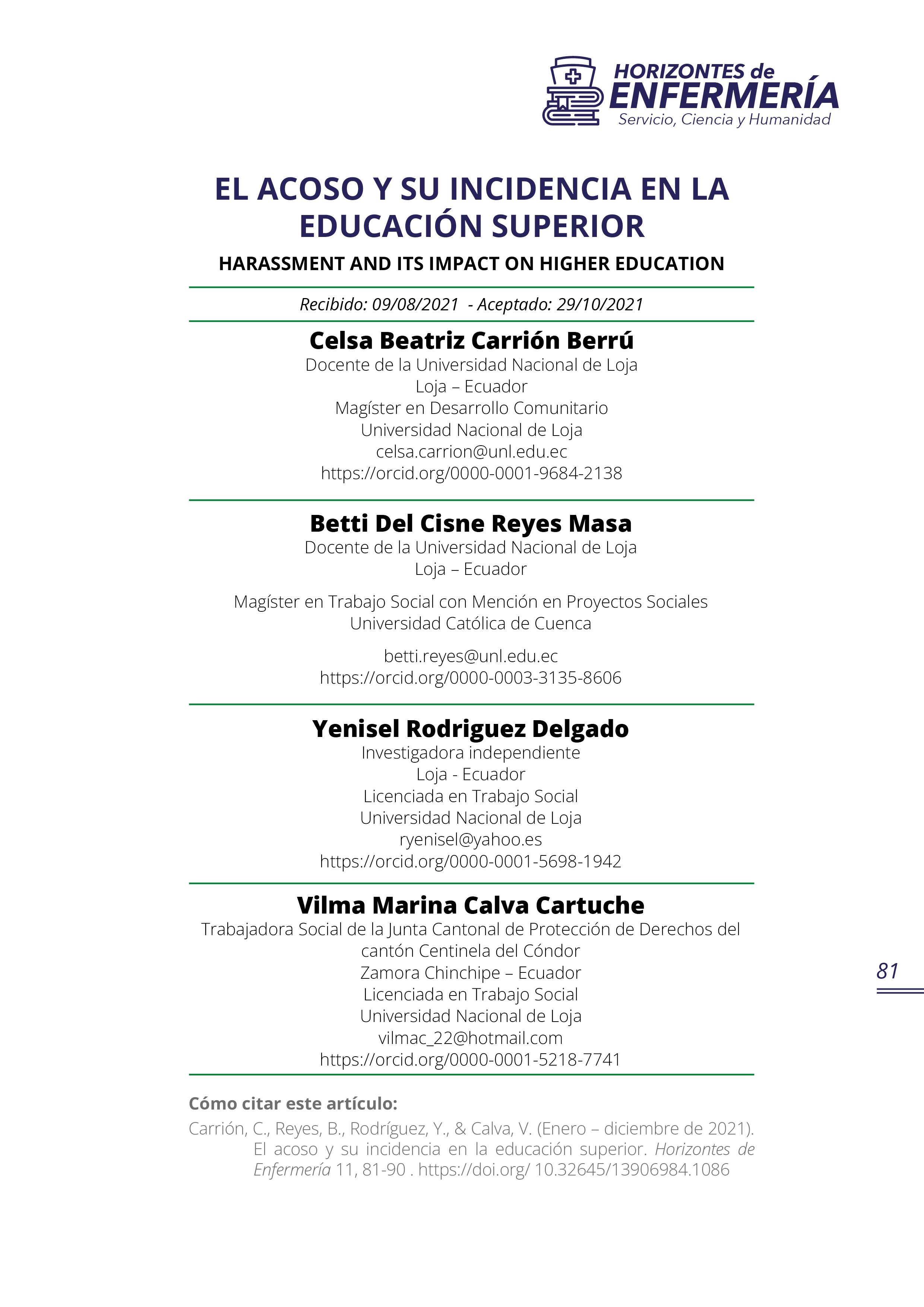Harassment and its impact on higher education
DOI:
https://doi.org/10.32645/13906984.1086Keywords:
Sexual harassment, Gender, Violence, Higher educationAbstract
Sexual harassment is a latent reality that arises in the various contexts where the human beings develop, being an expression of violence that reveals inequality and the exercise of power. Their presence within higher education institutions encourages them to seek reasons and explanations for this problem. The objective was to detect, address and report these types of practices that physically and emotionally harm the victim. The methodology used in the research
was a qualitative-quantitative, descriptive and cross-sectional study, through the application of an online survey to a sample of 2,166 students from the different faculties of the university. The results revealed that women experience sexual harassment to a greater extent than men, gender
inequality being unquestionable. Statistically speaking, of the 67.91% that corresponds to women, 15.74% state that they have suffered some type of sexual harassment during their stay on the university campus; While the male population which represents 32.04%, only 3.60% have been victims of this problem, and 0.05% corresponding to students who identified as intersex state that if they have suffered sexual harassment during their college life. Therefore, it is essential that the National University of Loja execute training campaigns for the entire university community on
the issue of sexual harassment, with a special focus on the prevention and eradication of these harmful practices.
References
Altamirano, G. (2020). Violencia de género en estudiantes universitarios. Una mirada desde la
determinación social (Tesis de Maestría). Universidad Andina Simón Bolívar, Quito, Ecuador. Recuperado de https://repositorio.uasb.edu.ec/bitstream/10644/7582/1/
T3295-MESC-Altamirano-Violencia.pdf
Aristegui Noticias. (6 de marzo de 2018). 46% de las mujeres mexicanas admiten haber sido víctimas de acoso sexual: BRAIN. Recuperado de https://aristeguinoticias.com/0603/kiosko/46-de-las-mujeres-mexicanas-admiten-haber-sido-victimas-de-acoso-sexual-brain/
El Comercio. (20 de noviembre de 2019). Acoso sexual, una constante en cuatro universidades de Quito. Recuperado de https://www.elcomercio.com/tendencias/sociedad/acoso-sexualinvestigacion-universidades-quito.html
Caudillo, L., Hernández, M., y Flores, M. (2017). Análisis De Los Determinantes Sociales De La
Violencia De Género. Ra Ximhai, 13(2), 87–96. Recuperado de https://www.redalyc.org/
articulo.oa?id=46154510007
Echeverría, R., Paredes, L., Evia, N. M., Carrillo, C. D., Kantún, M. D., Batún, J. L., y Quintal, R.
(2018). Caracterización del hostigamiento y acoso sexual, denuncia y atención recibida
por estudiantes universitarios mexicanos. Revista de Psicología, 27(2), 1–12. https://doi.
org/10.5354/0719-0581.2018.52307
Gutiérrez, C. (2016). Protocolos contra el acoso sexual en Educación Superior -Sugerencias
para su elaboración. Recuperado de https://www.mineduc.cl/wp-content/uploads/
sites/19/2017/09/Procolos-contra-el-acoso-sexual-en-ESUP.pdf
Instituto Nacional de Encuestas y Censo. (2019). Encuesta Nacional sobre Relaciones Familiares y Violencia de Género contra las Mujeres (ENVIGMU). Recuperado de https://www.
ecuadorencifras.gob.ec/documentos/web-inec/Estadisticas_Sociales/Violencia_de_
genero_2019/Boletin_Tecnico_ENVIGMU.pdf
Organización de las Naciones Unidas para la Educación, la Ciencia y la Cultura [UNESCO]. (2021). Mujeres en la educación superior: ¿la ventaja femenina ha puesto fin a las desigualdades de género? Recuperado de https://www.iesalc.unesco.org/wp-content/uploads/2021/03/Las-mujeres-en-la-educación-superior_12-03-21.pdf
Organización Mundial de la Salud. (2021). Violencia contra la mujer. Recuperado de https://www.who.int/es/news-room/fact-sheets/detail/violence-against-women
Pörhölä, Maili y Kinney, T. A. (2010). El acoso Contextos, consecuencias y control. Recuperado de https://books.google.com.pe/booksid=E0NkvDcYYVwC&printsec=copyright#v=onepage&q&f=false
Resolución No. 050 de 2020 [Procuraduría General del Estado]. Protocolo Interno contra la
Violencia de Género. 9 de julio de 2020. Recuperado de http://www.pge.gob.ec/images/2020/resoluciones/faltantes/RESOLUCIN_050_PROTOCOLO_INTERNO_CONTRA_LA_VIOLENCIA_DE_GêNERO.pdf
Reyes, A., y Rosero, R. (2005). Plan de Igualdad de Oportunidades de las Mujeres Ecuatorianas.
Recuperado de http://extwprlegs1.fao.org/docs/pdf/ecu164409.pdf
UNICEF. (2018). Postura de UNICEF respecto a la explotación, el abuso y el acoso sexual.
Recuperado de https://www.unicef.org/es/postura-de-unicef-respecto-la-explotacion-elabuso-y-el-acoso-sexual
Universidad Central del Ecuador. (2019, 22 de noviembre). Estudio sobre acoso sexual en
instituciones de educación superior es socializado [Boletín de prensa]. Recuperado
https://repositorio.uce.edu.ec/archivos/jmsalazara/Boletines/Boletines2019/2/594.pdf
Universidad Nacional de Loja y Unidad de Bienestar Universitario. (2019). Protocolo de Actuación
Integral contra el Acoso Sexual y Violencia de Género en la UNL. Recuperado de https://
www.unl.edu.ec/sites/default/files/servicios-tecnologicos/2020-08/MANUAL ACOSO
SEXUAL.pdf

Downloads
Published
Issue
Section
License
Copyright (c) 2021 Celsa Beatriz Carrión Berrú, Betti Del Cisne Reyes Masa, Yenisel Rodriguez Delgado, Vilma Marina Calva Cartuche

This work is licensed under a Creative Commons Attribution-NonCommercial-ShareAlike 4.0 International License.
El autor mantiene los derechos morales e intelectuales de su obra, autorizando a la editoruial de la revista revista Horizontes de Enfermería ladifusión y la divulgación de su contenido con fines estrictamente académicos y de investigación, sin fines de lucro.




